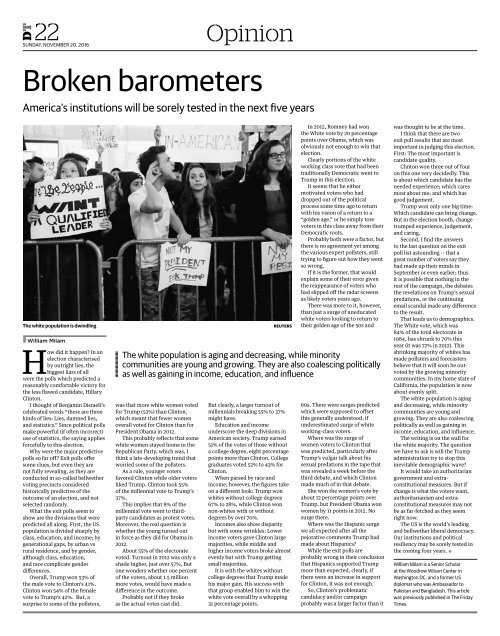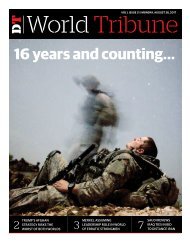e_Paper 20-11-2016
Create successful ePaper yourself
Turn your PDF publications into a flip-book with our unique Google optimized e-Paper software.
22<br />
SUNDAY, NOVEMBER <strong>20</strong>, <strong>20</strong>16<br />
DT<br />
Opinion<br />
Broken barometers<br />
America’s institutions will be sorely tested in the next five years<br />
The white population is dwindling<br />
• William Milam<br />
How did it happen? In an<br />
election characterised<br />
by outright lies, the<br />
biggest liars of all<br />
were the polls which predicted a<br />
reasonably comfortable victory for<br />
the less flawed candidate, Hillary<br />
Clinton.<br />
I thought of Benjamin Disraeli’s<br />
celebrated words “there are three<br />
kinds of lies: Lies, damned lies,<br />
and statistics.” Since political polls<br />
make powerful (if often incorrect)<br />
use of statistics, the saying applies<br />
forcefully to this election.<br />
Why were the major predictive<br />
polls so far off? Exit polls offer<br />
some clues, but even they are<br />
not fully revealing, as they are<br />
conducted in so-called bellwether<br />
voting precincts considered<br />
historically predictive of the<br />
outcome of an election, and not<br />
selected randomly.<br />
What the exit polls seem to<br />
show are the divisions that were<br />
predicted all along. First, the US<br />
population is divided sharply by<br />
class, education, and income; by<br />
generational gaps, by urban vs<br />
rural residence, and by gender,<br />
although class, education,<br />
and race complicate gender<br />
differences.<br />
Overall, Trump won 53% of<br />
the male vote to Clinton’s 41%.<br />
Clinton won 54% of the female<br />
vote to Trump‘s 42%. But, a<br />
surprise to some of the pollsters,<br />
was that more white women voted<br />
for Trump (53%) than Clinton,<br />
which meant that fewer women<br />
overall voted for Clinton than for<br />
President Obama in <strong>20</strong>12.<br />
This probably reflects that some<br />
white women stayed home in the<br />
Republican Party, which was, I<br />
think a late-developing trend that<br />
worried some of the pollsters.<br />
As a rule, younger voters<br />
favored Clinton while older voters<br />
liked Trump. Clinton took 55%<br />
of the millennial vote to Trump’s<br />
37%.<br />
This implies that 8% of the<br />
millennial vote went to thirdparty<br />
candidates as protest votes.<br />
Moreover, the real question is<br />
whether the young turned out<br />
in force as they did for Obama in<br />
<strong>20</strong>12.<br />
About 55% of the electorate<br />
voted. Turnout in <strong>20</strong>12 was only a<br />
shade higher, just over 57%, But<br />
one wonders whether one percent<br />
of the voters, about 1.5 million<br />
more votes, would have made a<br />
difference in the outcome.<br />
Probably not if they broke<br />
as the actual votes cast did.<br />
REUTERS<br />
But clearly, a larger turnout of<br />
millennials breaking 55% to 37%<br />
might have.<br />
Education and income<br />
underscore the deep divisions in<br />
American society. Trump earned<br />
51% of the votes of those without<br />
a college degree, eight percentage<br />
points more than Clinton. College<br />
graduates voted 52% to 43% for<br />
Clinton.<br />
When parsed by race and<br />
income, however, the figures take<br />
on a different look: Trump won<br />
whites without college degrees<br />
67% to 28%, while Clinton won<br />
non-whites with or without<br />
degrees by over 70%.<br />
Incomes also show disparity<br />
but with some wrinkles: Lower<br />
income voters gave Clinton large<br />
majorities, while middle and<br />
higher income voters broke almost<br />
evenly but with Trump getting<br />
small majorities.<br />
It is with the whites without<br />
college degrees that Trump made<br />
his major gain. His success with<br />
that group enabled him to win the<br />
white vote overall by a whopping<br />
31 percentage points.<br />
In <strong>20</strong>12, Romney had won<br />
the White vote by <strong>20</strong> percentage<br />
points over Obama, which was<br />
obviously not enough to win that<br />
election.<br />
Clearly portions of the white<br />
working class vote that had been<br />
traditionally Democratic went to<br />
Trump in this election.<br />
It seems that he either<br />
motivated voters who had<br />
dropped out of the political<br />
process some time ago to return<br />
with his vision of a return to a<br />
“golden age,” or he simply tore<br />
voters in this class away from their<br />
Democratic roots.<br />
Probably both were a factor, but<br />
there is no agreement yet among<br />
the various expert pollsters, still<br />
trying to figure out how they went<br />
so wrong.<br />
If it is the former, that would<br />
explain some of their error given<br />
the reappearance of voters who<br />
had slipped off the radar screens<br />
as likely voters years ago.<br />
There was more to it, however,<br />
than just a surge of uneducated<br />
white voters looking to return to<br />
their golden age of the 50s and<br />
The white population is aging and decreasing, while minority<br />
communities are young and growing. They are also coalescing politically<br />
as well as gaining in income, education, and influence<br />
60s. There were surges predicted<br />
which were supposed to offset<br />
this generally understood, if<br />
underestimated surge of white<br />
working-class voters.<br />
Where was the surge of<br />
women voters to Clinton that<br />
was predicted, particularly after<br />
Trump’s vulgar talk about his<br />
sexual predations in the tape that<br />
was revealed a week before the<br />
third debate, and which Clinton<br />
made much of in that debate.<br />
She won the women’s vote by<br />
about 12 percentage points over<br />
Trump, but President Obama won<br />
women by <strong>11</strong> points in <strong>20</strong>12. No<br />
surge there.<br />
Where was the Hispanic surge<br />
we all expected after all the<br />
pejorative comments Trump had<br />
made about Hispanics?<br />
While the exit polls are<br />
probably wrong in their conclusion<br />
that Hispanics supported Trump<br />
more than expected, clearly, if<br />
there were an increase in support<br />
for Clinton, it was not enough.<br />
So, Clinton’s problematic<br />
candidacy and/or campaign<br />
probably was a larger factor than it<br />
was thought to be at the time.<br />
I think that there are two<br />
exit poll results that are most<br />
important in judging this election.<br />
First: The most important is<br />
candidate quality.<br />
Clinton won three out of four<br />
on this one very decidedly. This<br />
is about which candidate has the<br />
needed experience; which cares<br />
most about me; and which has<br />
good judgement.<br />
Trump won only one big time:<br />
Which candidate can bring change.<br />
But in the election booth, change<br />
trumped experience, judgement,<br />
and caring.<br />
Second, I find the answers<br />
to the last question on the exit<br />
poll list astounding -- that a<br />
great number of voters say they<br />
had made up their minds in<br />
September or even earlier; thus<br />
it is possible that nothing in the<br />
rest of the campaign, the debates<br />
the revelations on Trump’s sexual<br />
predations, or the continuing<br />
email scandal made any difference<br />
to the result.<br />
That leads us to demographics.<br />
The White vote, which was<br />
84% of the total electorate in<br />
1984, has shrunk to 70% this<br />
year (it was 72% in <strong>20</strong>12). This<br />
shrinking majority of whites has<br />
made pollsters and forecasters<br />
believe that it will soon be outvoted<br />
by the growing minority<br />
communities. In my home state of<br />
California, the population is now<br />
about evenly split.<br />
The white population is aging<br />
and decreasing, while minority<br />
communities are young and<br />
growing. They are also coalescing<br />
politically as well as gaining in<br />
income, education, and influence.<br />
The writing is on the wall for<br />
the white majority. The question<br />
we have to ask is will the Trump<br />
administration try to stop this<br />
inevitable demographic wave?<br />
It would take an authoritarian<br />
government and extraconstitutional<br />
measures. But if<br />
change is what the voters want,<br />
authoritarianism and extraconstitutional<br />
measures may not<br />
be as far-fetched as they seem<br />
right now.<br />
The US is the world’s leading<br />
and bellwether liberal democracy.<br />
Our institutions and political<br />
resiliency may be sorely tested in<br />
the coming four years. •<br />
William Milam is a Senior Scholar<br />
at the Woodrow Wilson Center in<br />
Washington DC, and a former US<br />
diplomat who was Ambassador to<br />
Pakistan and Bangladesh. This article<br />
was previously published in The Friday<br />
Times.


















